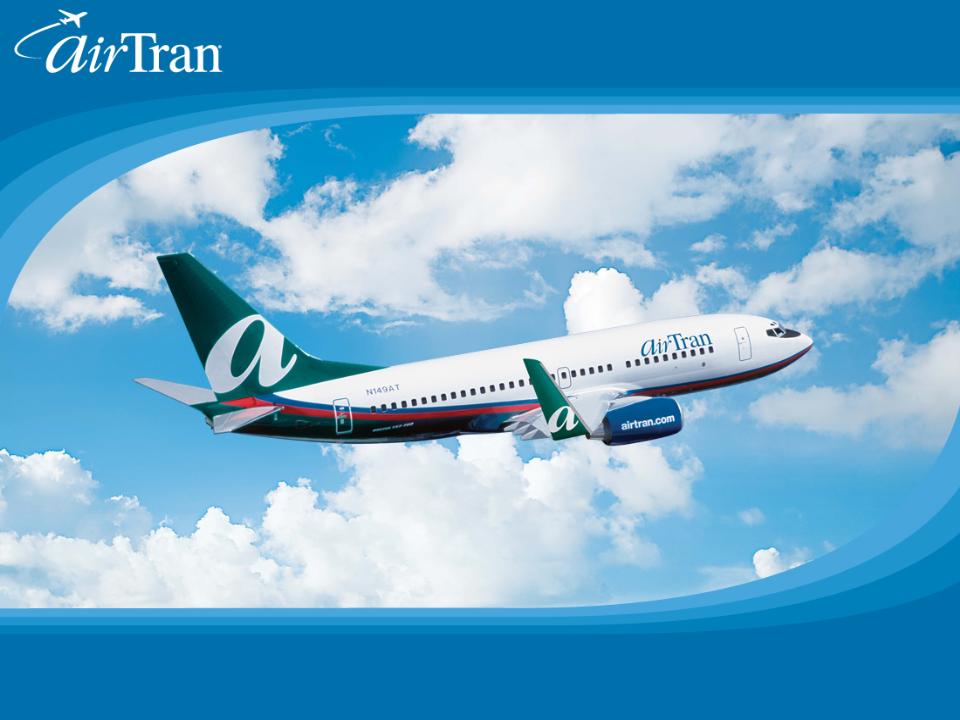Attached files
| file | filename |
|---|---|
| 8-K - AIRTRAN AIRWAYS FORM 8-K FOR PRESENTATION PROVIDED AT ANNUAL SHAREHOLDER MEETING 05.18.10 - AIRTRAN HOLDINGS INC | form8-k.htm |
EXHIBIT 99.1

May 2010
May 2010
2010 Annual Shareholder Meeting
2010 Annual Shareholder Meeting

2
Certain of the statements contained herein should be considered “forward-looking statements,” including within the meaning of the
Private Securities Litigation Reform Act of 1995. These forward-looking statements may be identified by words such as “may”, “will”,
“expect,” “intend,” “indicate,” “anticipate,” “believe,” “forecast,” “estimate,” “plan, “ “guidance,” “outlook,” “could, “ “should,” “continue”
and similar terms used in connection with statements regarding the outlook of AirTran Holdings, Inc., (the “Company” or “AirTran”). Such
statements include, but are not limited to, statements about the Company’s: expected financial performance and operations, expected fuel
costs, the revenue and pricing environment, future financing plans and needs, overall economic condition and its business plans, objectives,
expectations and intentions. Other forward-looking statements that do not relate solely to historical facts include, without limitation,
statements that discuss the possible future effects of current known trends or uncertainties or which indicate that the future effects of known
trends or uncertainties cannot be predicted, guaranteed or assured. Such statements are based upon the current beliefs and expectations of
the Company’s management and are subject to significant risks and uncertainties that could cause the Company’s actual results and financial
position to differ materially from the Company’s expectations. Such risks and uncertainties include, but are not limited to, the following: the
Company’s ability to grow new and existing markets, the Company’s ability to maintain or expand cost advantages in comparison to various
competitors, the impact of high fuel costs; significant disruptions in the supply of aircraft fuel and further significant increases to fuel prices;
the Company’s ability to attract and retain qualified personnel; labor costs and relations with unionized employees generally and the impact
and outcome of labor negotiations; the impact of global instability, including the current instability in the Middle East, the continuing impact of
the U.S. military presence in Iraq and Afghanistan and the terrorist attacks of September 11, 2001 and the potential impact of future hostilities,
terrorist attacks, infectious disease outbreaks or other global events that affect travel behavior; adequacy of insurance coverage; reliance on
automated systems and the potential impact of any failure or disruption of these systems; the potential impact of future significant operating
losses; the Company’s ability to obtain and maintain commercially reasonable terms with vendors and service providers and its reliance on
those vendors and service providers; security-related and insurance costs; changes in government legislation and regulation; competitive
practices in the industry, including significant fare restructuring activities, capacity reductions and in-court or out-of-court restructuring by
major airlines and industry consolidation; interruptions or disruptions in service at one or more of the Company’s hub or focus airports;
weather conditions; the impact of fleet concentration and changes in fleet mix; the impact of increased maintenance costs as aircraft age
and/or utilization increases; the Company’s ability to maintain adequate liquidity; the Company’s ability to maintain contracts that are critical to
its operations; the Company’s fixed obligations and its ability to obtain and maintain financing for operations, aircraft financing and other
purposes; changes in prevailing interest rates; the Company’s ability to operate pursuant to the terms of any financing facilities (particularly
the financial covenants) and to maintain compliance with credit card agreements; the Company’s ability to attract and retain customers; the
cyclical nature of the airline industry; economic conditions; risks associated with actual or potential acquisitions or other business
transactions including the Company’s ability to achieve any synergies anticipated as a result of such transactions and to achieve any such
synergies in a timely manner, and other risks and uncertainties listed from time to time in the Company’s reports to the Securities and
Exchange Commission. There may be other factors not identified above of which the Company is not currently aware that may affect matters
discussed in the forward-looking statements, and may also cause actual results to differ materially from those discussed. All forward-looking
statements are based on information currently available to the Company. Except as may be required by applicable law, AirTran assumes no
obligation to publicly update or revise any forward-looking statement to reflect actual results, changes in assumptions or changes in other
factors affecting such estimates. Additional factors that may affect the future results of the Company are set forth in the section entitled “Risk
Factors” in the Company’s Annual Report on Form 10-K for the period ended December 31, 2009, or as supplemented in the Company’s
subsequently filed periodic reports, which are available at www.sec.gov and at www.AirTran.com.
Private Securities Litigation Reform Act of 1995. These forward-looking statements may be identified by words such as “may”, “will”,
“expect,” “intend,” “indicate,” “anticipate,” “believe,” “forecast,” “estimate,” “plan, “ “guidance,” “outlook,” “could, “ “should,” “continue”
and similar terms used in connection with statements regarding the outlook of AirTran Holdings, Inc., (the “Company” or “AirTran”). Such
statements include, but are not limited to, statements about the Company’s: expected financial performance and operations, expected fuel
costs, the revenue and pricing environment, future financing plans and needs, overall economic condition and its business plans, objectives,
expectations and intentions. Other forward-looking statements that do not relate solely to historical facts include, without limitation,
statements that discuss the possible future effects of current known trends or uncertainties or which indicate that the future effects of known
trends or uncertainties cannot be predicted, guaranteed or assured. Such statements are based upon the current beliefs and expectations of
the Company’s management and are subject to significant risks and uncertainties that could cause the Company’s actual results and financial
position to differ materially from the Company’s expectations. Such risks and uncertainties include, but are not limited to, the following: the
Company’s ability to grow new and existing markets, the Company’s ability to maintain or expand cost advantages in comparison to various
competitors, the impact of high fuel costs; significant disruptions in the supply of aircraft fuel and further significant increases to fuel prices;
the Company’s ability to attract and retain qualified personnel; labor costs and relations with unionized employees generally and the impact
and outcome of labor negotiations; the impact of global instability, including the current instability in the Middle East, the continuing impact of
the U.S. military presence in Iraq and Afghanistan and the terrorist attacks of September 11, 2001 and the potential impact of future hostilities,
terrorist attacks, infectious disease outbreaks or other global events that affect travel behavior; adequacy of insurance coverage; reliance on
automated systems and the potential impact of any failure or disruption of these systems; the potential impact of future significant operating
losses; the Company’s ability to obtain and maintain commercially reasonable terms with vendors and service providers and its reliance on
those vendors and service providers; security-related and insurance costs; changes in government legislation and regulation; competitive
practices in the industry, including significant fare restructuring activities, capacity reductions and in-court or out-of-court restructuring by
major airlines and industry consolidation; interruptions or disruptions in service at one or more of the Company’s hub or focus airports;
weather conditions; the impact of fleet concentration and changes in fleet mix; the impact of increased maintenance costs as aircraft age
and/or utilization increases; the Company’s ability to maintain adequate liquidity; the Company’s ability to maintain contracts that are critical to
its operations; the Company’s fixed obligations and its ability to obtain and maintain financing for operations, aircraft financing and other
purposes; changes in prevailing interest rates; the Company’s ability to operate pursuant to the terms of any financing facilities (particularly
the financial covenants) and to maintain compliance with credit card agreements; the Company’s ability to attract and retain customers; the
cyclical nature of the airline industry; economic conditions; risks associated with actual or potential acquisitions or other business
transactions including the Company’s ability to achieve any synergies anticipated as a result of such transactions and to achieve any such
synergies in a timely manner, and other risks and uncertainties listed from time to time in the Company’s reports to the Securities and
Exchange Commission. There may be other factors not identified above of which the Company is not currently aware that may affect matters
discussed in the forward-looking statements, and may also cause actual results to differ materially from those discussed. All forward-looking
statements are based on information currently available to the Company. Except as may be required by applicable law, AirTran assumes no
obligation to publicly update or revise any forward-looking statement to reflect actual results, changes in assumptions or changes in other
factors affecting such estimates. Additional factors that may affect the future results of the Company are set forth in the section entitled “Risk
Factors” in the Company’s Annual Report on Form 10-K for the period ended December 31, 2009, or as supplemented in the Company’s
subsequently filed periodic reports, which are available at www.sec.gov and at www.AirTran.com.
Safe Harbor

3
n Record net income
― GAAP $134.7MM, economic $93.6MM
n Lowest stage length adjusted unit costs among major airlines
― Non-fuel CASM 6.39 cents
n Continued to diversify the network
― Initiated service to seven domestic cities and four Caribbean destinations
― Added over thirty new routes to the network
n Completed installation of Gogo Inflight Internet on entire fleet
n Ranked #1 among all Continental U.S. airlines for the third
consecutive year in the Airline Quality Rating
consecutive year in the Airline Quality Rating
AirTran Airways 2009 Highlights
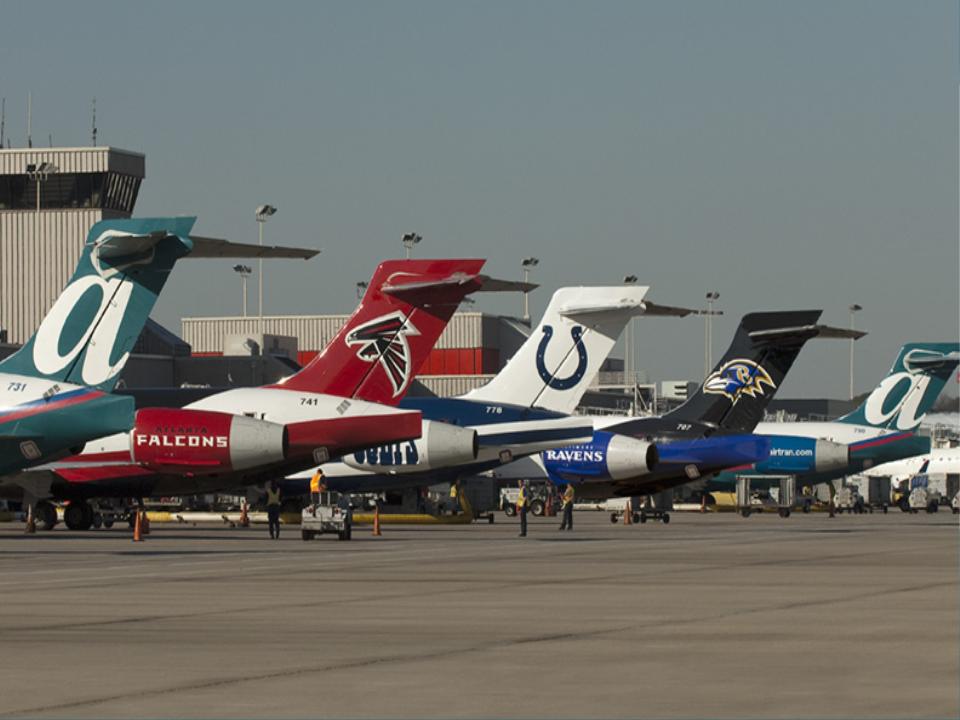
2009: Launch of Four Sport-Themed Aircraft

5
n 17 year-old Company
― 8th largest U.S. airline
― 138 all-Boeing aircraft - 86 717s / 52 737-700s
n 71 cities served
n Over 8,100 Crew Members
n 2009 sales of $2.3 billion
― Grown from under $450 million in sales in 1998
n Restored record of profitability
― Profitable 9 out of the last 10 years
AirTran Airways Today
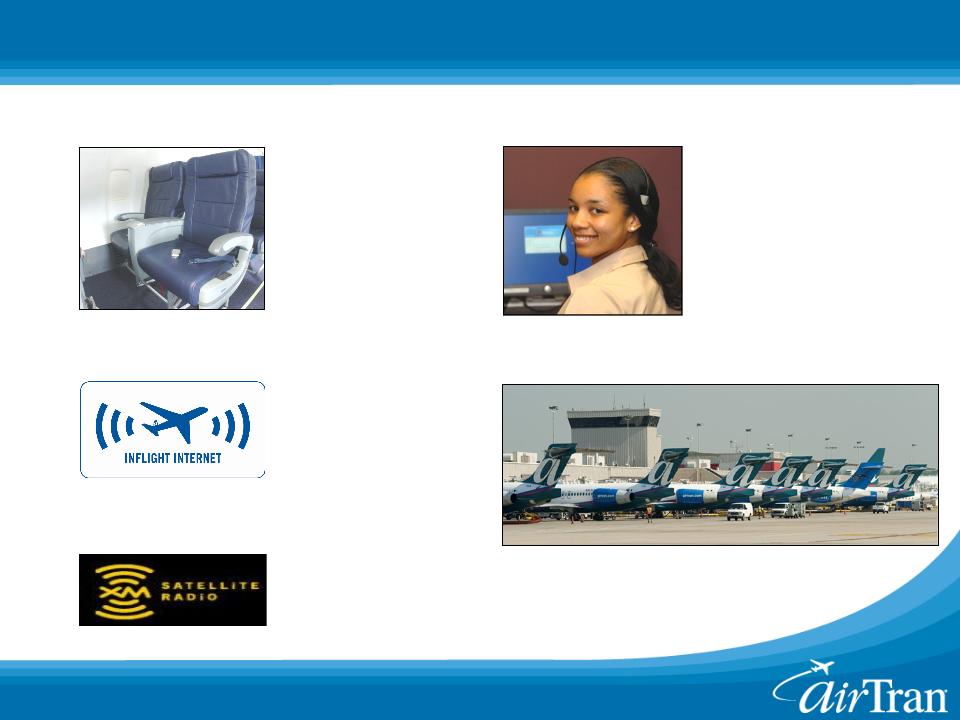
6
n Business Class
n High speed internet
n XM Radio
On Every AirTran Flight…
n Friendly Crew Members
n Young all-Boeing fleet
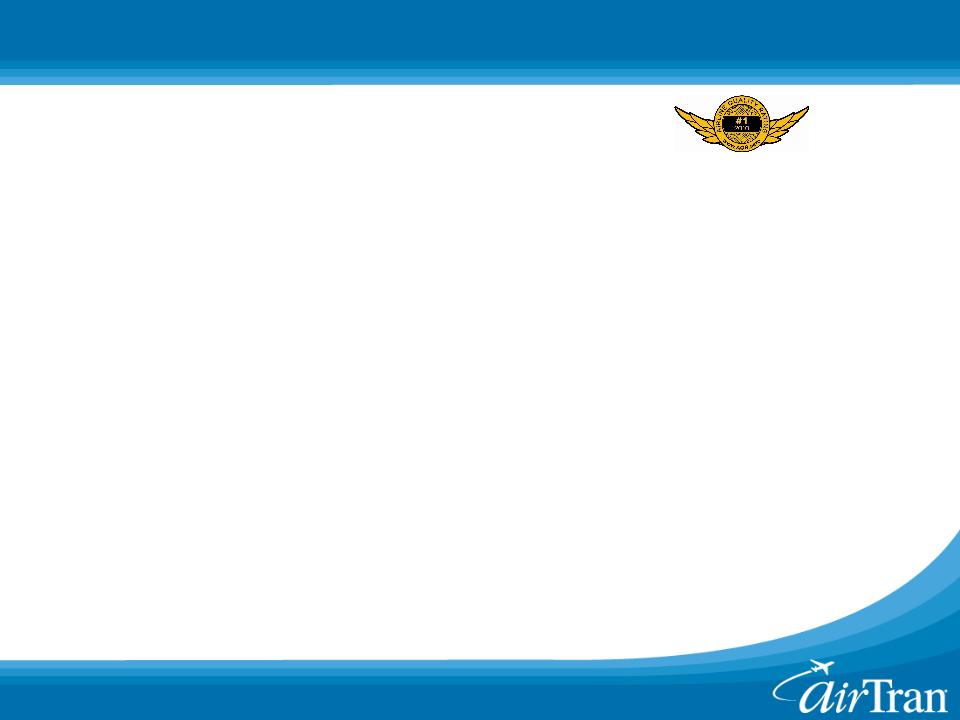
7
n Industry leading low costs and high quality
n Conservative fleet plan and disciplined growth
n Strong ancillary revenues
― Less dependent on initial sale to passenger
― 11% of total revenue in 2009
n Better diversified network
― More than 700 daily departures to over 70 destinations
n Improved fuel hedge portfolio
n Industry backdrop remains favorable
AirTran Investment Highlights
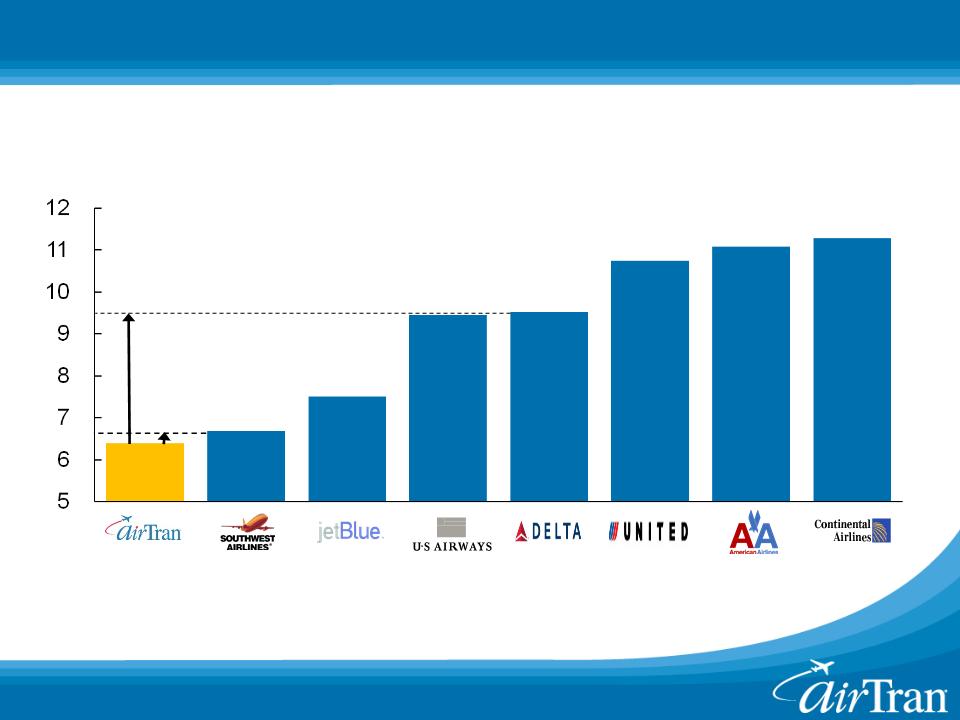
8
(Cents)
Note: Excludes fuel and special items
Industry Cost Comparison
Non-Fuel Unit Costs at 738 Miles for 2009
AirTran Remains Industry Cost Leader
49% Higher
5% Higher
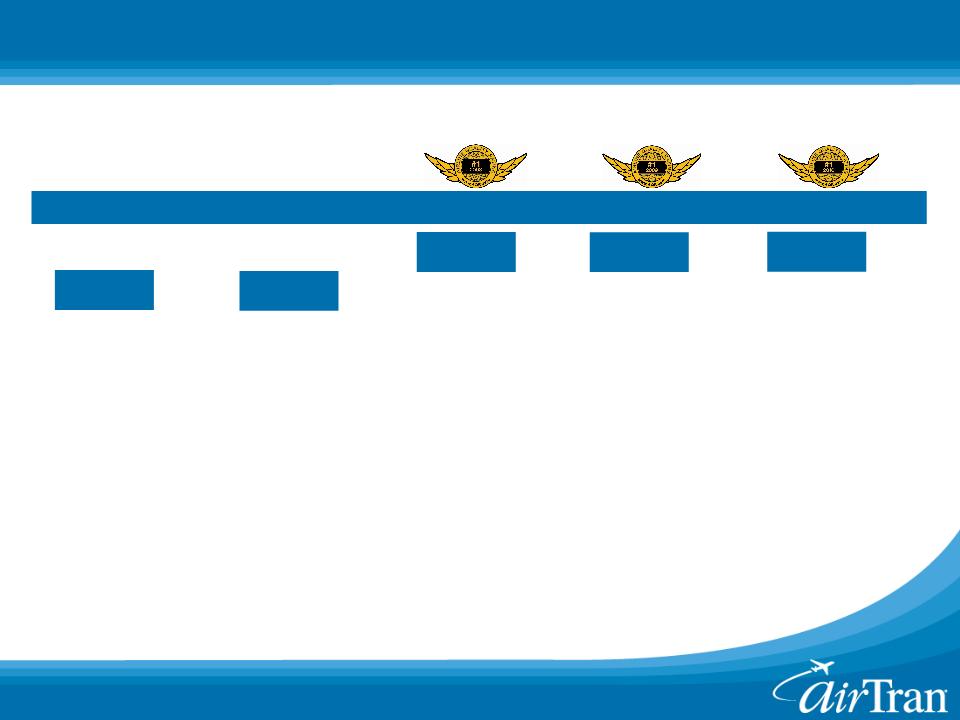
JetBlue
AirTran
Independence
Southwest
United
America West
Northwest
Continental
Alaska
American
AirTran
JetBlue
Northwest
Alaska
Southwest
Frontier
Continental
American
US Airways
United
AirTran
JetBlue
Southwest
Northwest
Frontier
Continental
Alaska
United
American
Delta
JetBlue
AirTran
Frontier
Northwest
Southwest
Continental
United
Alaska
American
ATA
9
Notes: (1) AQR Rating compiled by Purdue University / Wichita State University.
(2) Based on DOT reports for on-time performance, denied boardings, mishandled baggage, & customer complaints
1.
2.
3.
4.
5.
6.
7.
8.
9.
10.
Airline Quality Rating for Continental U.S. Airlines
2008
2007
2006
2009
2010
AirTran
JetBlue
Northwest
Southwest
Continental
Frontier
US Airways
American
ExpressJet
Alaska
AirTran Ranks High in Industry Quality
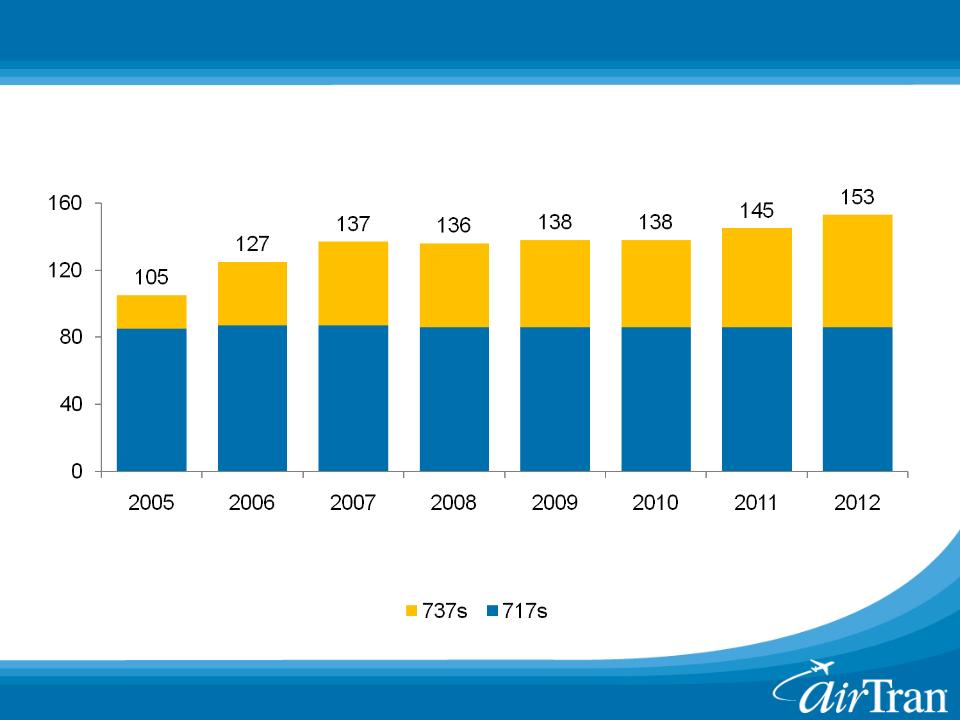
10
(Aircraft)
Current Fleet Plan Allows for Disciplined Growth
n Currently 138 aircraft: 86 717s / 52 737-700s
|
28%
|
24%
|
20%
|
5%
|
(2)%
|
3-4%
|
3-4%
|
5-7%
|
ASM
Growth
Growth
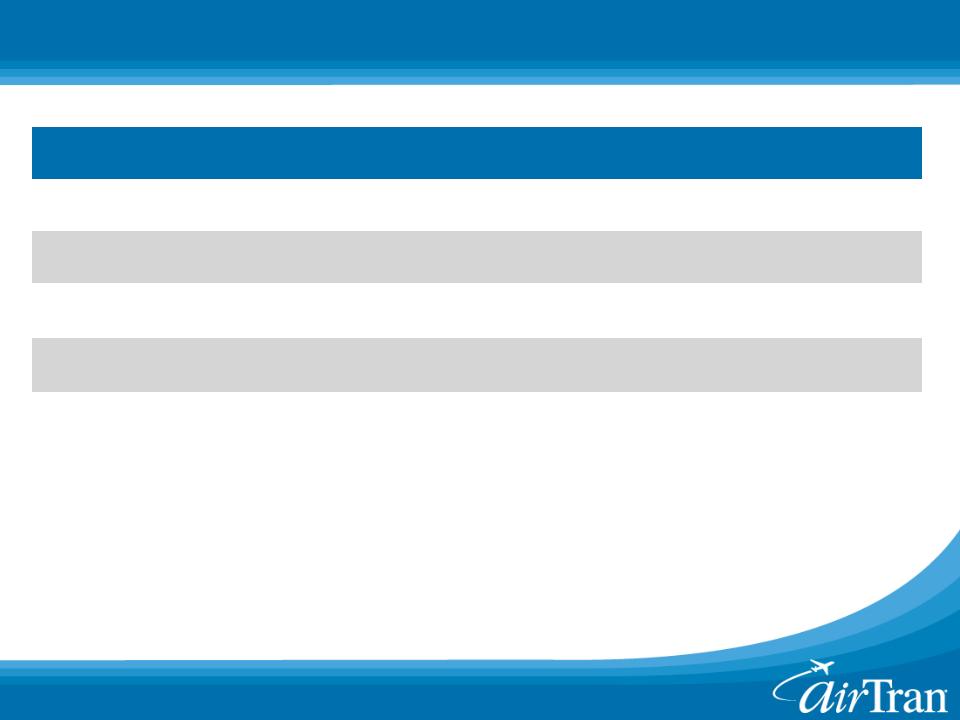
11
AirTran Has Successfully Diversified Its Network
|
% ASMs
|
2000
|
2002
|
2004
|
2006
|
2008
|
2010E
|
|
Atlanta
|
91%
|
76%
|
67%
|
64%
|
58%
|
47%
|
|
Florida
|
29%
|
35%
|
34%
|
38%
|
45%
|
41%
|
|
Baltimore
|
0%
|
13%
|
13%
|
9%
|
11%
|
13%
|
|
Milwaukee
|
0%
|
3%
|
3%
|
2%
|
7%
|
13%
|
|
Caribbean
|
0%
|
1%
|
1%
|
0%
|
3%
|
6%
|
|
|
|
|
|
|
|
|
|
Daily Flights
|
278
|
362
|
492
|
650
|
713
|
713
|
Note: Totals >100% as percentage of ASMs represents capacity from a city/region to the entire AirTran network at year-end
Source: 2010E based on March 2010 schedule

12
(ASM
Growth)
Growth)
Composition of AirTran’s Year-Over-Year Growth
AirTran 2010 Available Seat Mile Growth
3 - 4%
~1.0 %
~1.5%
~1.25%
~0.75%
~0.5%
(~1.5%)
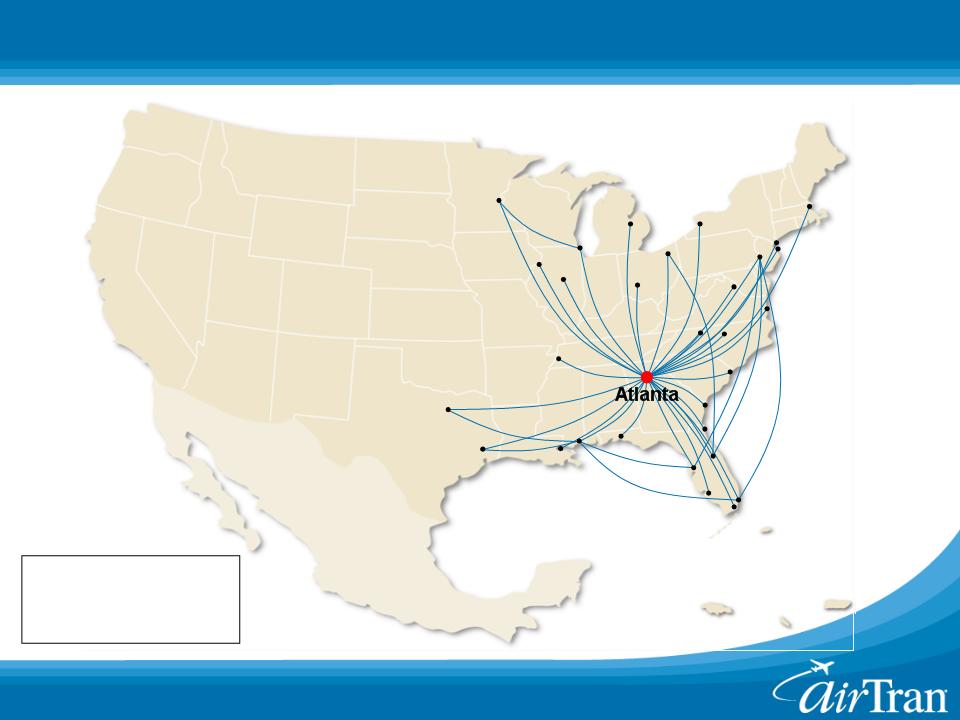
13
Boston
Flint
Moline
Buffalo
Dayton
Dallas/Ft. Worth
Houston
New Orleans
Memphis
Bloomington
Minneapolis
Akron/
Canton
Newport News
New York (LGA)
Ft. Lauderdale
AirTran Had a Regional Route Network in 2000
Gulfport/Biloxi
Fort Walton Beach
Miami
Ft. Myers
Orlando
Jacksonville
Savannah
Myrtle Beach
Raleigh/Durham
Greensboro
Washington, D.C. (IAD)
Philadelphia
Newark
Chicago
Tampa
Cities: 31
Routes: 40
Stage Length: 537
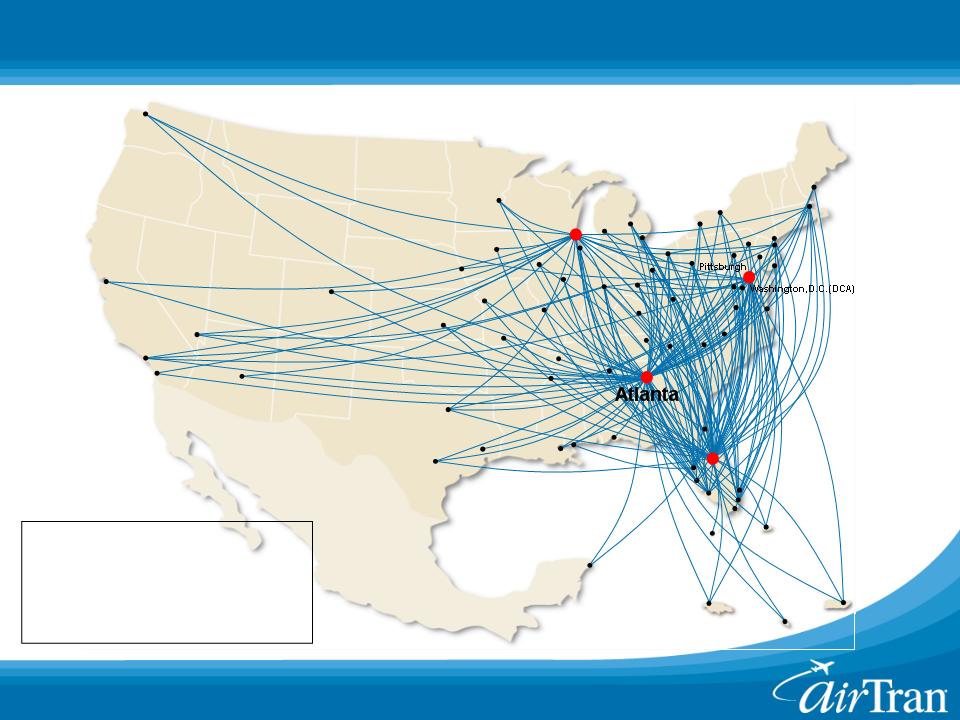
14
Portland
Dallas/Ft. Worth
Las Vegas
Minneapolis
San Antonio
Flint
San Juan
Montego Bay
Aruba
Rochester
San Diego
Los Angeles
Seattle
San Francisco
Wichita
New Orleans
Cancun
Knoxville
Lexington
Buffalo
Boston
Allentown
Akron/
Canton
Jacksonville
Orlando
West Palm Beach
Ft. Lauderdale
Miami
Nassau
Gulfport
Memphis
St. Louis
Kansas City
Omaha
Des Moines
Moline
Bloomington
Indianapolis
Chicago
Milwaukee
Phoenix
Denver
Harrisburg
Tampa
Sarasota
Ft. Myers
Key West
AirTran’s 2010 Network is Better Diversified
Grand Rapids
Detroit
Columbus
Dayton
Charleston
Houston
Pensacola
Asheville
Branson
Huntsville
Richmond
Tunica
Newport News
Baltimore
Atlantic City
Philadelphia
New York (LGA)
White Plains
Washington, D.C. (IAD)
Raleigh/Durham
Charlotte
Change from 2000
Cities: 31 to 71
Routes: 40 to 190
Stage Length: 537 to 752
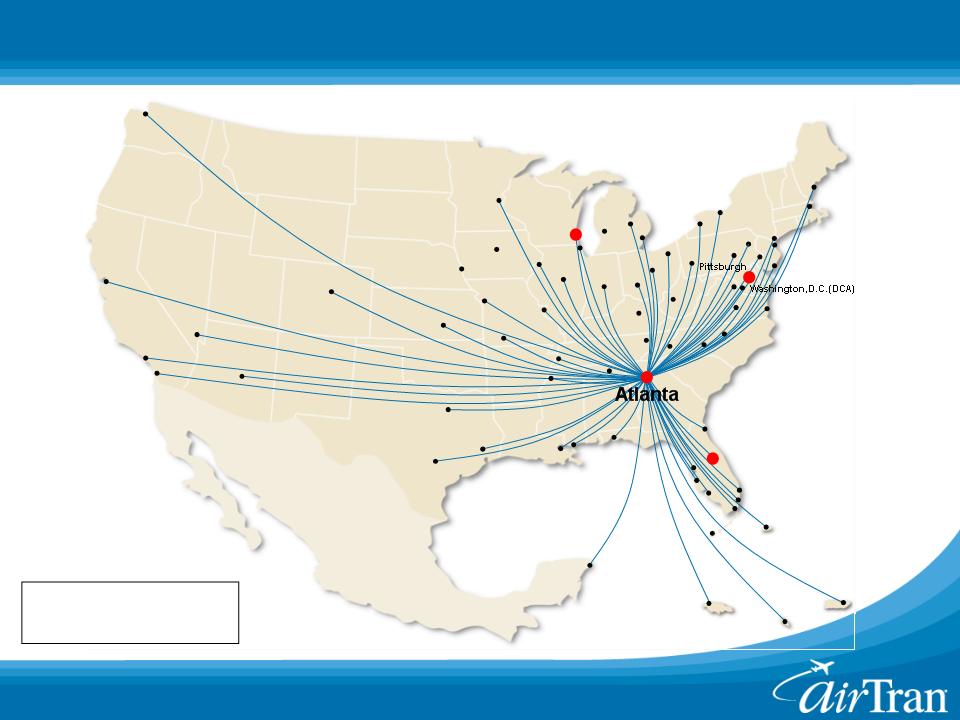
15
Boston
Dallas/Ft. Worth
Las Vegas
Denver
Minneapolis
San Antonio
Houston
San Juan
Cancun
Montego Bay
Aruba
Newport News
Rochester
Kansas City
Columbus
Akron/
Canton
San Diego
Los Angeles
Phoenix
Seattle
San Francisco
Milwaukee
Moline
Chicago
Gulfport
Memphis
Branson
Wichita
St. Louis
Indianapolis
Bloomington
New Orleans
Dayton
Buffalo
Jacksonville
West Palm Beach
Ft. Lauderdale
Miami
Nassau
Orlando
Tampa
Pensacola
Sarasota
Ft. Myers
AirTran’s 2010 Atlanta Network Has Grown to 60 Cities
Flint
Detroit
Grand Rapids
Charleston
Knoxville
Lexington
Allentown
Harrisburg
Key West
Portland
Omaha
Des Moines
Richmond
Asheville
Huntsville
Tunica
Routes: 60
Stage Length: 682
Charlotte
Raleigh/Durham
Washington, D.C. (IAD)
Baltimore
Atlantic City
Philadelphia
New York (LGA)
White Plains
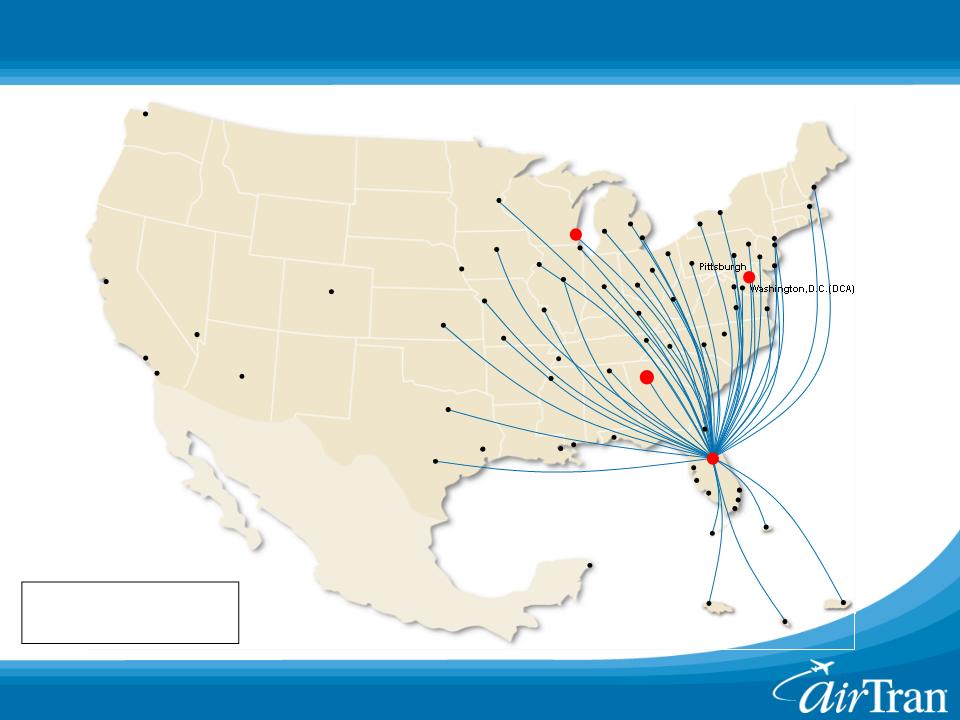
16
Portland
Dallas/Ft. Worth
Las Vegas
Minneapolis
San Antonio
Houston
San Juan
Montego Bay
Aruba
Rochester
San Diego
Los Angeles
Seattle
San Francisco
Wichita
New Orleans
Cancun
White Plains
New York (LGA)
Philadelphia
Atlantic City
Washington, D.C. (IAD)
Newport News
Richmond
Raleigh/Durham
Charlotte
Knoxville
Lexington
Buffalo
Boston
Allentown
Akron/
Canton
Jacksonville
Orlando
West Palm Beach
Ft. Lauderdale
Miami
Nassau
Gulfport
Memphis
St. Louis
Kansas City
Omaha
Des Moines
Moline
Bloomington
Indianapolis
Chicago
Milwaukee
Phoenix
Denver
Harrisburg
Sarasota
Ft. Myers
Key West
Baltimore
Flint
Grand Rapids
Asheville
Columbus
Dayton
Charleston
Detroit
Tampa
Pensacola
Branson
Huntsville
Atlanta
Tunica
AirTran Now Serves the Most Destinations from Orlando
Routes: 47
Stage Length: 801
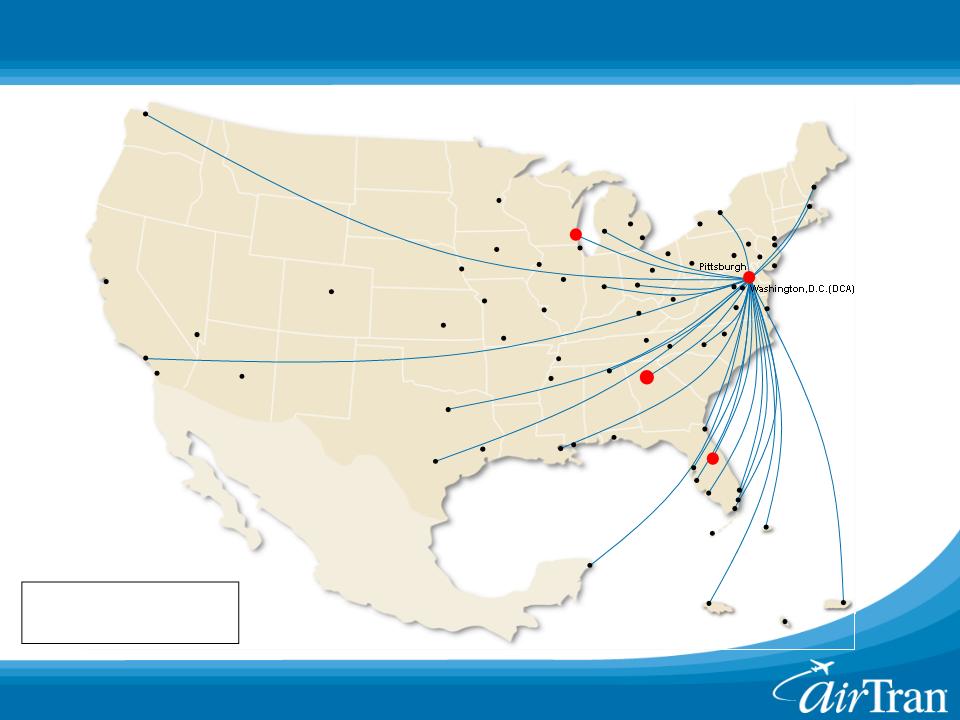
17
Portland
Dallas/Ft. Worth
Las Vegas
Minneapolis
San Antonio
San Juan
Montego Bay
Aruba
Rochester
San Diego
Los Angeles
Seattle
San Francisco
Branson
Wichita
New Orleans
Cancun
White Plains
New York (LGA)
Philadelphia
Atlantic City
Newport News
Dayton
Charleston
Knoxville
Lexington
Columbus
Buffalo
Boston
Allentown
Akron/
Canton
Jacksonville
Orlando
West Palm Beach
Ft. Lauderdale
Miami
Nassau
Gulfport
Memphis
St. Louis
Kansas City
Omaha
Des Moines
Moline
Bloomington
Indianapolis
Chicago
Milwaukee
Phoenix
Denver
Harrisburg
Atlanta
Pensacola
Tampa
Sarasota
Ft. Myers
Key West
Baltimore
Flint
Grand Rapids
Detroit
Asheville
Houston
Huntsville
Richmond
Tunica
Baltimore Provides a Strong Northeast Footprint
Washington, D.C. (IAD)
Raleigh/Durham
Charlotte
Routes: 27
Stage Length: 711
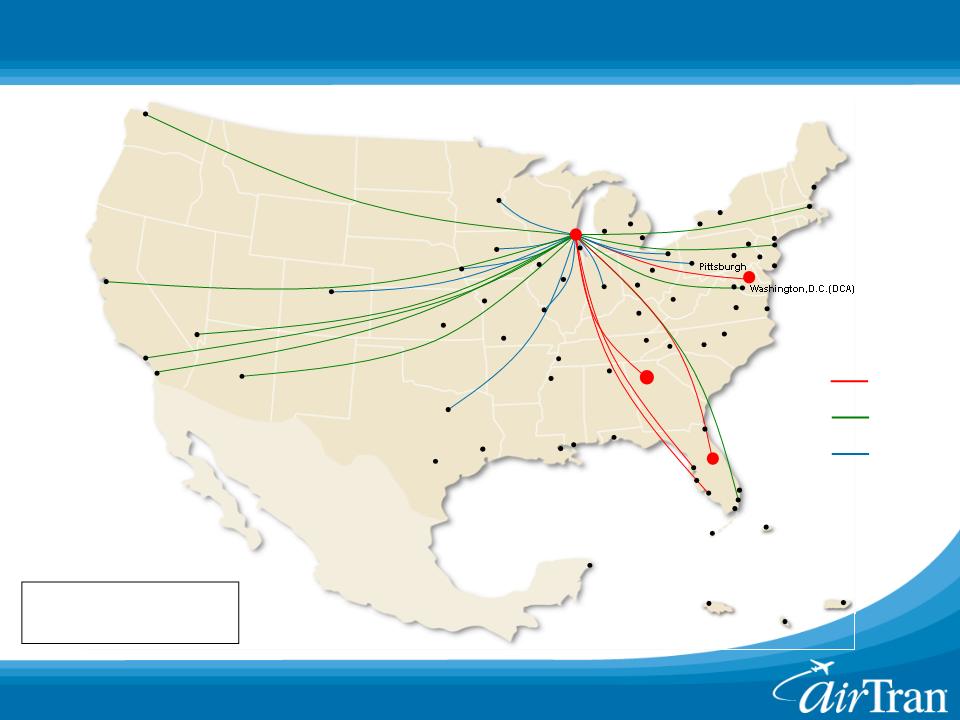
18
Portland
Dallas/Ft. Worth
Las Vegas
Minneapolis
San Antonio
Houston
San Juan
Montego Bay
Aruba
Rochester
San Diego
Los Angeles
Seattle
San Francisco
Branson
Wichita
New Orleans
Cancun
White Plains
New York (LGA)
Philadelphia
Atlantic City
Washington, D.C. (IAD)
Newport News
Dayton
Charleston
Richmond
Raleigh/Durham
Charlotte
Asheville
Knoxville
Lexington
Columbus
Buffalo
Boston
Allentown
Akron/
Canton
Jacksonville
Orlando
West Palm Beach
Ft. Lauderdale
Miami
Nassau
Gulfport
Memphis
St. Louis
Kansas City
Omaha
Des Moines
Moline
Bloomington
Indianapolis
Chicago
Milwaukee
Phoenix
Denver
Harrisburg
Atlanta
Pensacola
Tampa
Sarasota
Ft. Myers
Key West
Baltimore
Flint
Detroit
Grand Rapids
Huntsville
Tunica
AirTran is Now Milwaukee’s Largest Mainline Carrier
Routes: 24
Stage Length: 764
2006
2008
2010
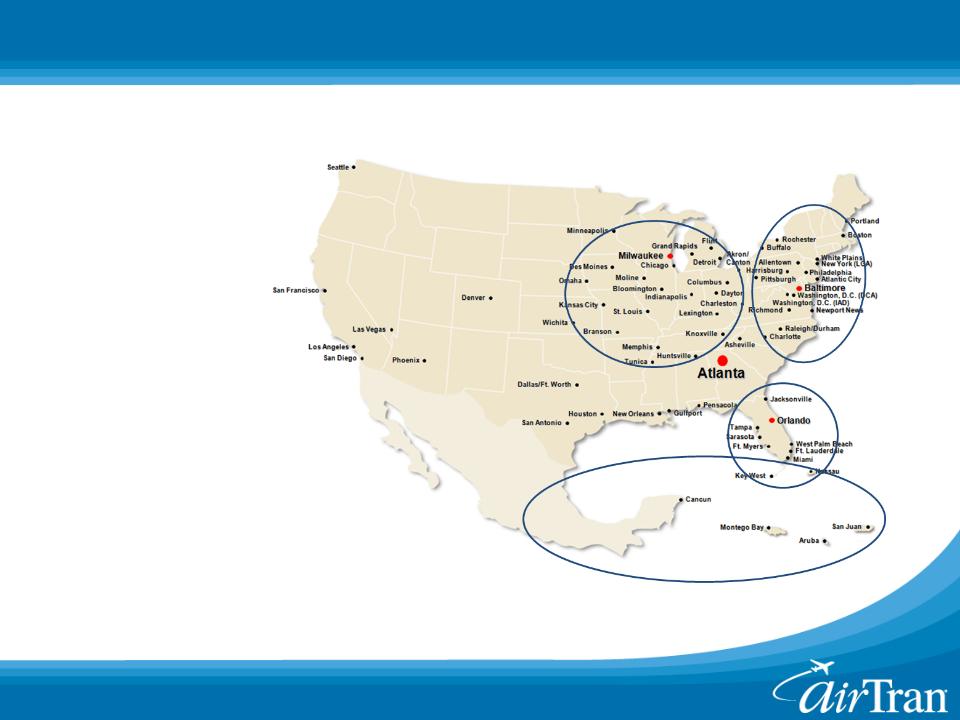
19
n Milwaukee / Upper Midwest
n Florida
n Latin America
n Baltimore
n Atlanta
Future Growth Opportunities

The Case for AirTran Growing Milwaukee
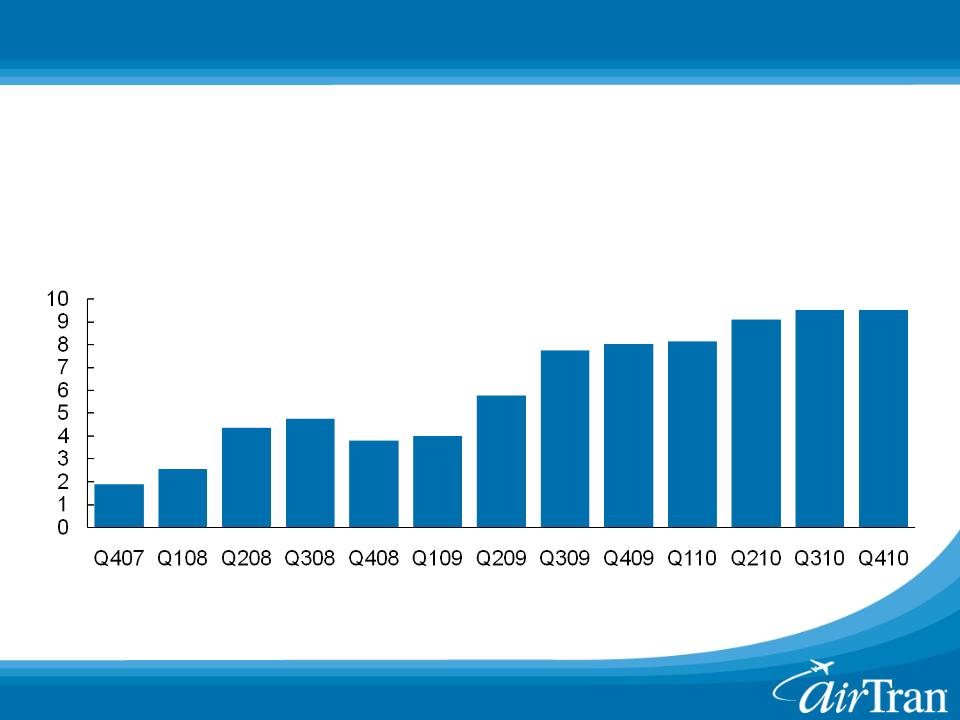
21
(ASMs in
Millions)
Millions)
AirTran’s Milwaukee Network Has Matured
AirTran Milwaukee Daily ASMs
(Passenger Market Share Shown Above)
n AirTran now serves 18 of the top 20 markets
n Latest passenger market share report exceeds 30%
8%
9%
12%
16%
16%
19%
21%
26%
26%
30%
>30%
>30%
>30%
Source: www.apgdat.com
Note: Estimated passenger market share for Q210 - Q410 based on scheduled seats
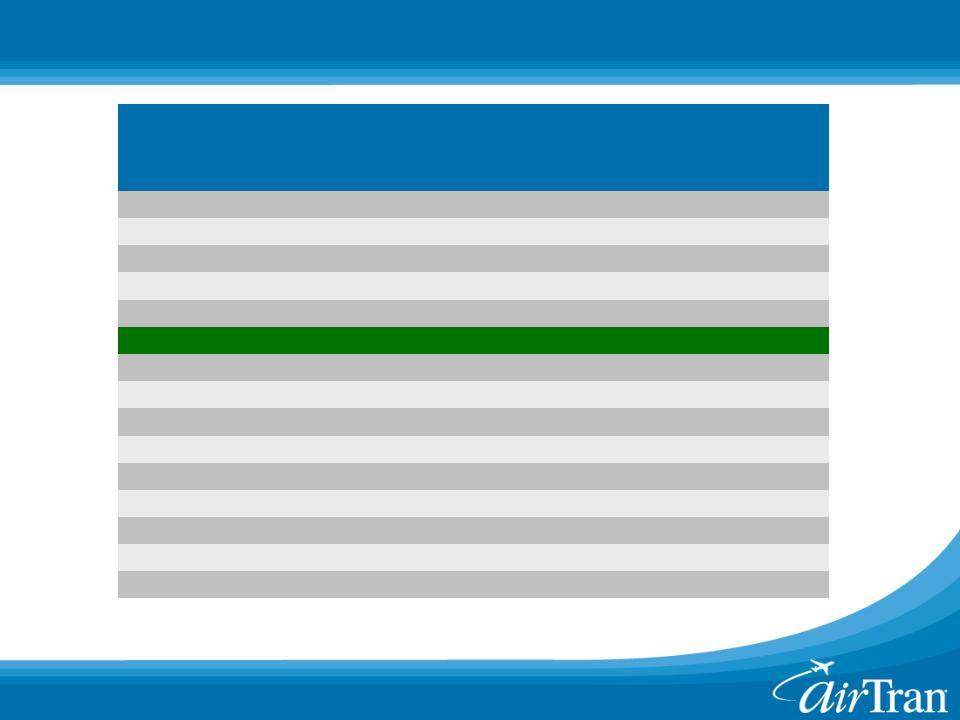
22
Milwaukee is Larger than Most Mid-Sized Hub Cities
|
Mid-Sized
Hub Cities
|
Population within
60 Miles (Millions) |
Fortune 500
Companies Headquarters |
|
Detroit
|
6.4
|
18
|
|
Atlanta
|
4.6
|
10
|
|
Cleveland
|
3.9
|
11
|
|
Pittsburgh
|
3.7
|
7
|
|
Seattle
|
3.6
|
8
|
|
Milwaukee
|
3.4
|
7
|
|
Minneapolis
|
3.3
|
18
|
|
Phoenix
|
3.2
|
5
|
|
Cincinnati
|
3.1
|
8
|
|
Denver
|
2.9
|
10
|
|
St. Louis
|
2.8
|
6
|
|
Charlotte
|
2.6
|
9
|
|
Indianapolis
|
2.5
|
4
|
|
Kansas City
|
2.3
|
3
|
|
Memphis
|
1.5
|
3
|
Source: www.apgdat.com, www.money.cnn.com
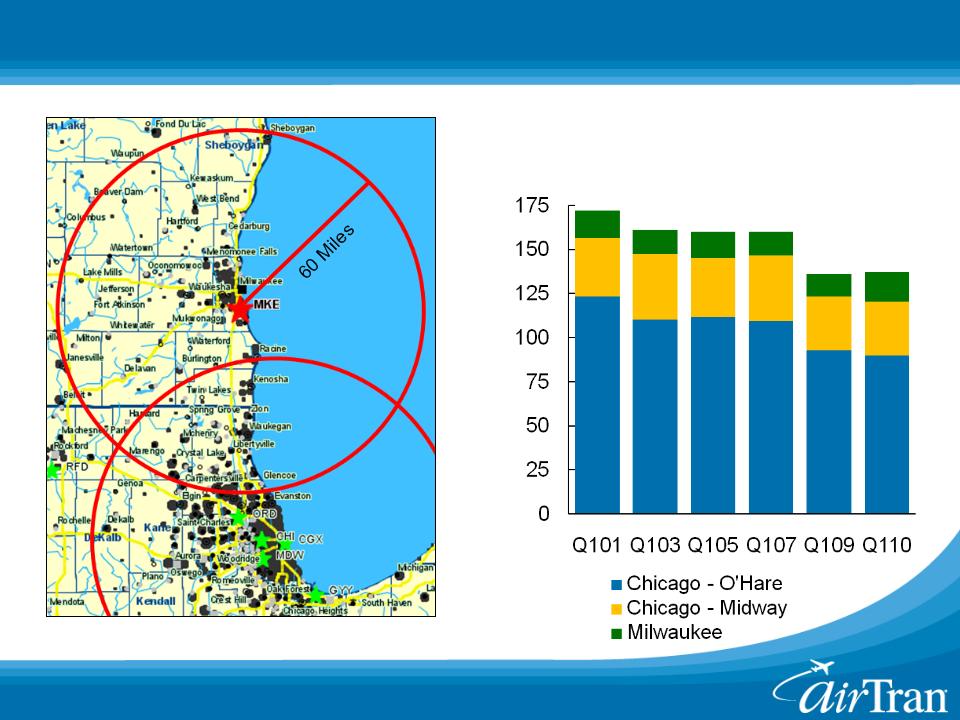
23
Milwaukee Plays Big Role in Downsized Chicago Region
(Daily Seats 000s)
Chicago / Milwaukee
Region Capacity
Region Capacity
Milwaukee population: 3.4 million

Industry Issues and Outlook

25
(Billions)
(Billions)
Legacy Airline Domestic Net Income
Reasons Behind Legacy Consolidation
Source: DOT Form 41 Filings and company reported financials
Annual
Cumulative
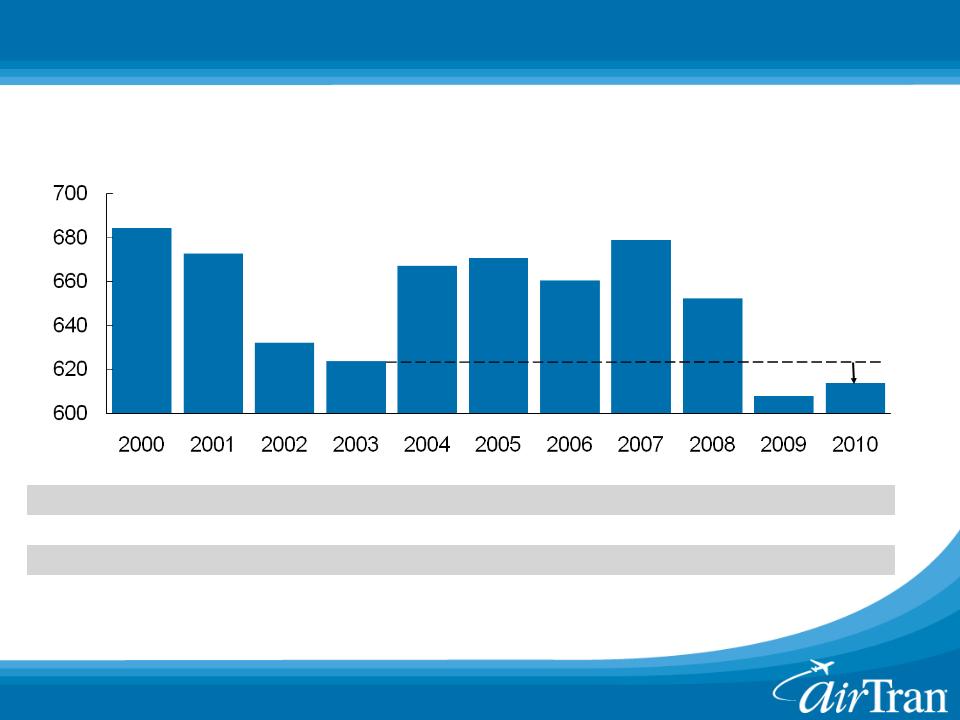
26
26
Source: www.apgdat.com
(Billions)
Continental U.S. Available Seat Miles
|
|
82%
|
79%
|
76%
|
72%
|
69%
|
64%
|
61%
|
59%
|
57%
|
56%
|
55%
|
|
|
6%
|
7%
|
8%
|
10%
|
12%
|
14%
|
14%
|
14%
|
14%
|
15%
|
16%
|
|
|
12%
|
14%
|
16%
|
18%
|
19%
|
22%
|
25%
|
27%
|
29%
|
29%
|
29%
|
Legacy
Regional
LCC
Domestic Capacity Remains at Very Low Levels
(2%)
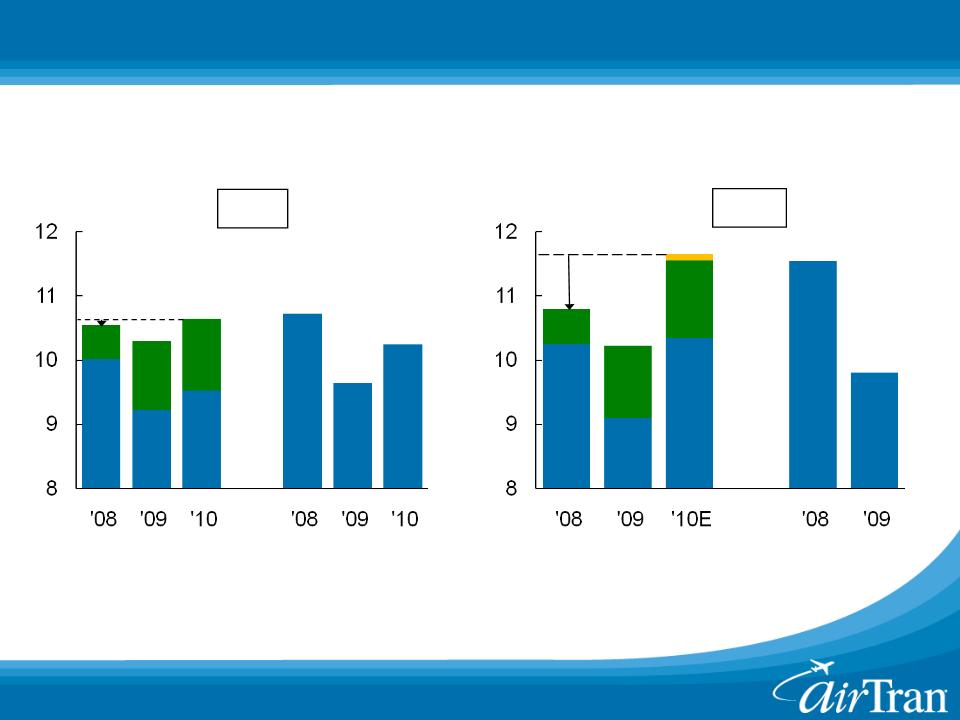
27
Revenue Trends are Accelerating
AirTran and ATA Industry Unit Revenue
(Cents)
(Cents)
Q1
AirTran
(PRASM/TRASM)
(PRASM/TRASM)
ATA
(PRASM)
(PRASM)
Q2
Note: Unit revenue adjusted to Q1 2010 passenger length of haul for both AirTran and ATA
1%
~8%
AirTran
(PRASM/TRASM)
(PRASM/TRASM)
ATA
(PRASM)
(PRASM)
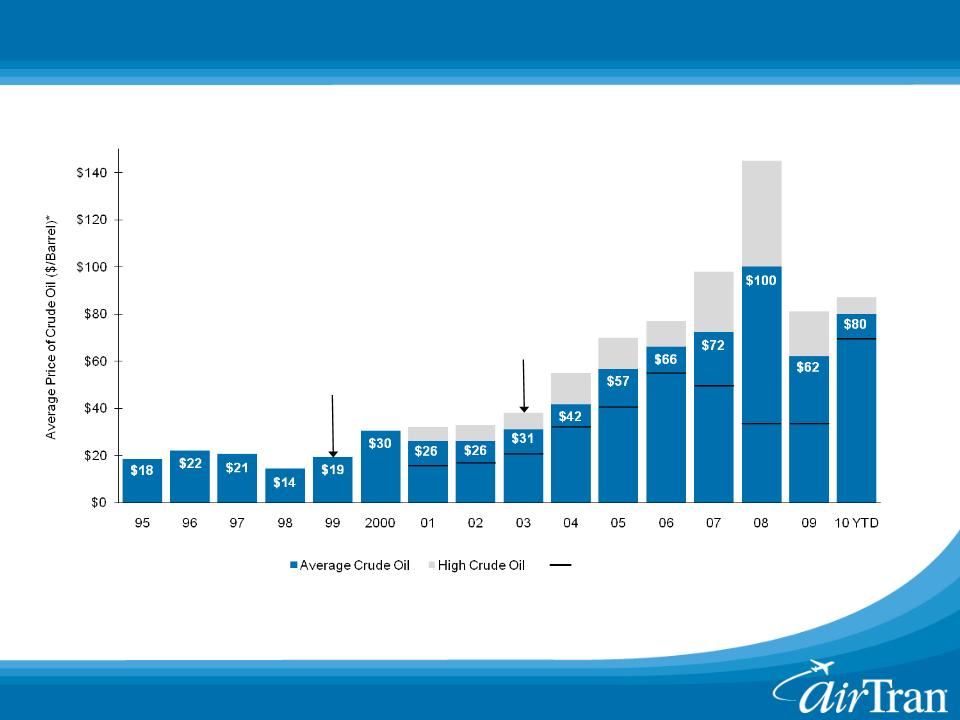
28
Fuel Prices Remain a Challenge for All Airlines
*West Texas Intermediate Crude Oil
Sources: Air Transport Association, Energy Information Administration, PIRA Energy Group, Deutsche Bank
(Cost per Barrel)
Crude Oil
Delivery of
1st B717
1st B717
Order 100
B737s
B737s
$32
$33
$38
$55
$70
$77
$145
$98
$81
$87
$17
$18
$25
$32
$42
$56
$50
$34
$34
$72
Low Crude Oil
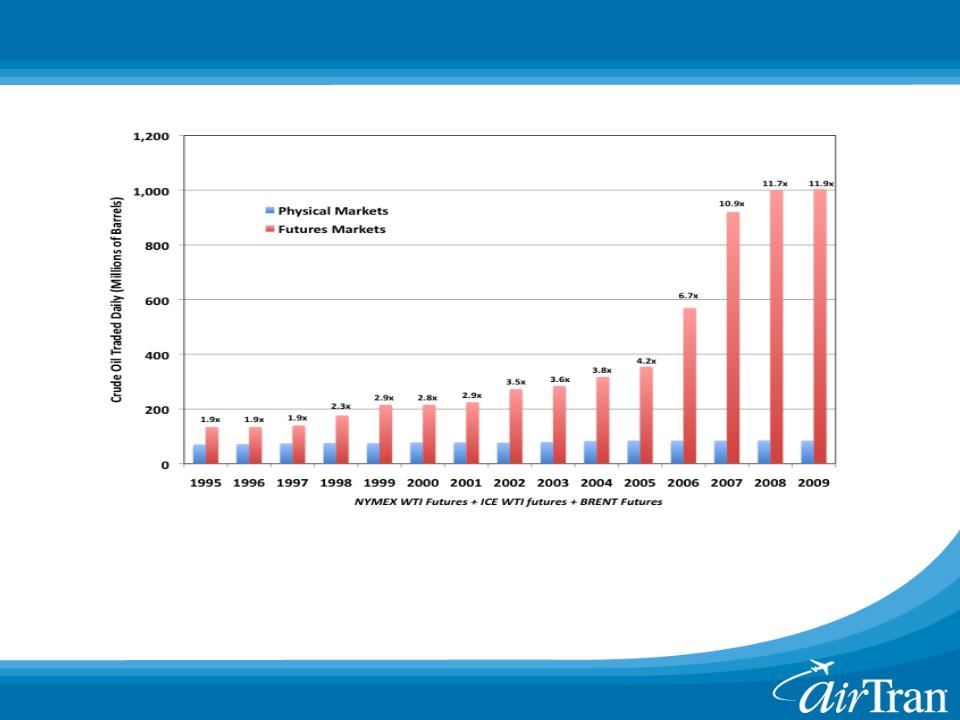
29
Speculation is Accelerating Fuel Volatility
Source: Bloomberg, EIA
www.stopoilspeculationnow.com

30
30
|
|
|
Crude Price
|
||
|
Period
|
Hedge %
|
$50
|
$70
|
$90
|
|
Q210
|
51%
|
$67
|
$77
|
$84
|
|
Q310
|
70%
|
$72
|
$78
|
$89
|
|
Q410
|
57%
|
$65
|
$76
|
$88
|
|
2010
|
56%
|
$72
|
$78
|
$84
|
|
2011
|
29%
|
$68
|
$72
|
$90
|
n One of few airlines to actively hedge for 2010
n Comprised of calls and wide collars
n Portfolio has no upside limits
Example: If crude was $90 in 2010, our cost would be the
equivalent of $84/bbl on 56% of our fuel, which includes the
cost of the premiums paid
equivalent of $84/bbl on 56% of our fuel, which includes the
cost of the premiums paid
51%
70%
56%
57%
Note: Assumes crack spread at 10% of crude price.
For FY2010, actual crude price is assumed
January through March.
For FY2010, actual crude price is assumed
January through March.
29%
Hedge Portfolio
AirTran is Committed to Reducing Fuel Cost Volatility

31
n Capacity up approximately 4%
n Estimated total unit revenue (TRASM) to be up 13% to 14%
― Revenue trends continue to accelerate in Q2
n Average economic cost per gallon of fuel all-in is $2.37 to $2.42
― Approximately 60% hedged for second half 2010
n Non-fuel unit cost up 4.0% to 4.5%
― Non-fuel unit cost for full-year 2010 up 4% to 5%
n Plan to pay $96MM of convertible debt with cash in July 2010
Q2 2010 Outlook is Positive

32
n Track record of profitability was restored in 2009
― Industry leading low costs and a high quality product drove record profitability
across multiple market segments
across multiple market segments
n Company has been successfully repositioned
― Disciplined fleet plan with multiple growth opportunities
― Successful diversification of our network
― Effective hedge portfolio - Increased protection in 2H10 and 2011
n Robust recovery in yields
― Rapid year-to-date yield improvement continuing into Q2
― Expect double-digit increase in Q2 TRASM versus prior year
AirTran Investment Summary
